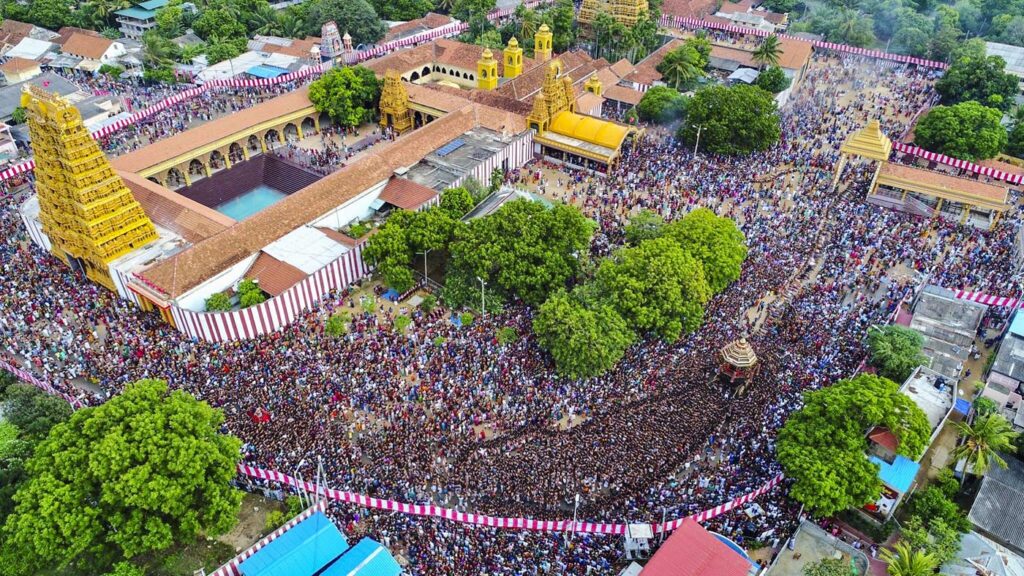Every year in the fall, tens of thousands of Hindus and others come to participate in all or part of the 25-day annual festival of Sri Lanka’s most famous Murugan temple. The magnificent event, managed by the temple’s priest trustees, takes place with unmatched precision and devotion at every stage.
Every year in the fall, tens of thousands of Hindus and others come to participate in all or part of the 25-day annual festival of Sri Lanka’s most famous Murugan temple. The magnificent event, managed by the temple’s priest trustees, takes place with unmatched precision and devotion at every stage.
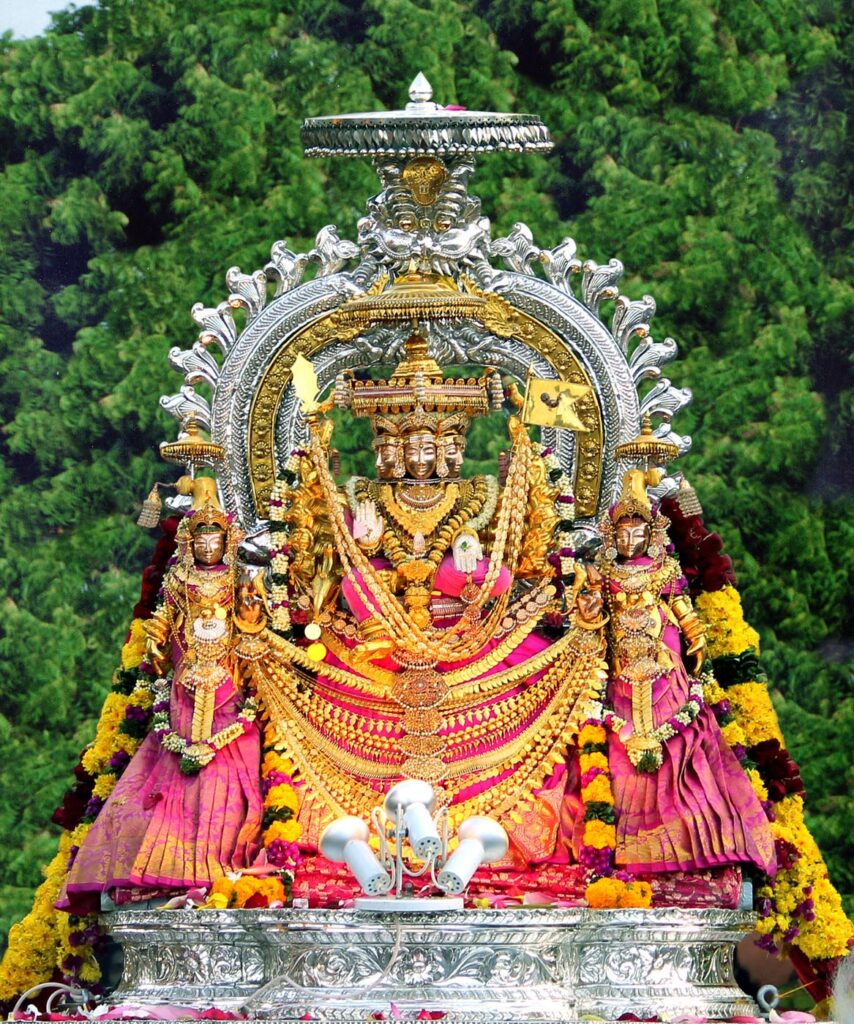
Unknown
By Balakumar Muthu, Chennai
In august 2024, i visited the nallur Kandaswamy Temple to attend the final days of the grand annual festival. It was a transformative experience. This iconic temple dedicated to Lord Murugan—here in the form of Alankara Kanthan or “Lord of Exquisite Adornment”—is located in the Jaffna District in the north of Sri Lanka. Stepping through its gates, I was immediately struck by the temple’s grandeur, history and the palpable devotion that filled the air. The temple has existed for over a thousand years, a resilient testament to the faith, artistry and spirituality of the island’s Tamil Hindu community.
Nallur was once the capital of the Jaffna Kingdom, and this temple is deeply embedded in the region’s rich heritage. Ancient Tamil texts, such as Yalpana Vaipava Malai and Kailaya Malai, highlight the temple’s significance. Its foundation was laid in 948ce, during the Chola dynasty. Over the centuries, the temple endured multiple challenges, including destruction in 1621 by the Portuguese, who replaced it with a church. Yet, the spirit of Nallur persisted. In 1749, under Dutch rule, key figures such as Krishna Suba Iyer and Ragunatha Maapaana Mudaliyar led efforts to rebuild the temple, restoring it to its former glory with the support of the Tamil community.
The architecture, shaped under the guidance of Kumarathas Mappana Muthaliyar, achieves a delicate balance with nature by integrating the five elements—fire, water, earth, wind and space—into its design. Currently the temple is managed by a dedicated trust that has successfully preserved its ancient practices while evolving to meet the needs of modern devotees. Unlike nearly every temple in India, it is not under any form of government control, but devotedly managed by the descendants of Ragunatha Mudaliyar.
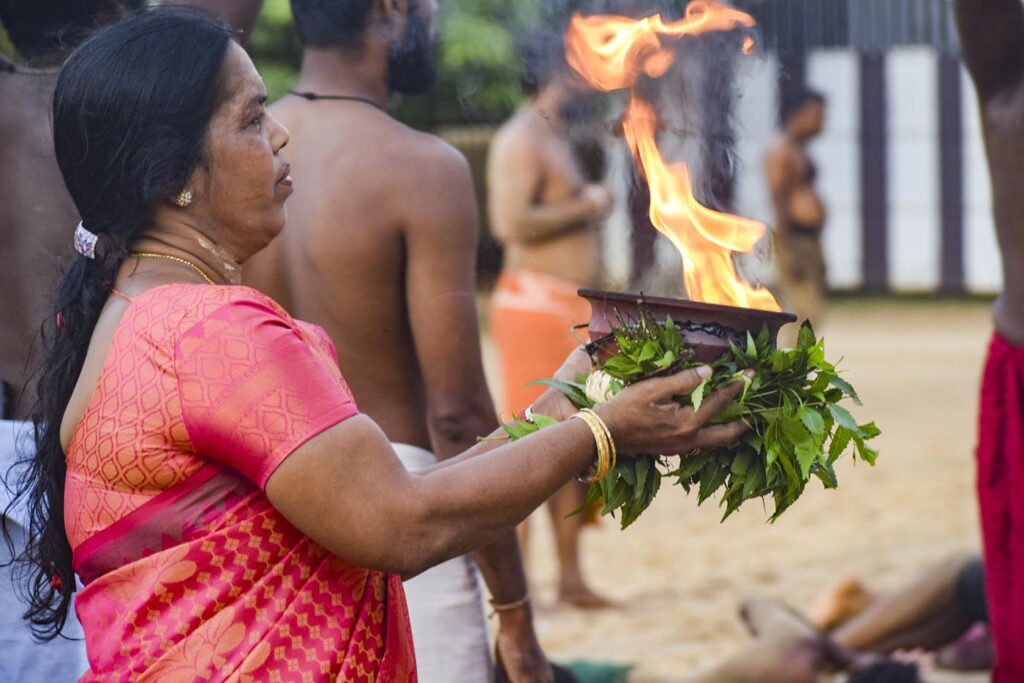
Inside, six daily pujas are conducted with precision and devotion, adhering to Saiva Agama traditions. The priests, or archakas, perform their duties with such reverence that Muruga’s divine presence is palpable. Their chanting of Vedic mantras, coupled with the pujas, creates an atmosphere of profound spirituality. A total of some 60 priests were present for this annual festival, both the permanent staff and others invited to help with the enormous event.
Adherence to Tradition
Nallur Kandaswamy Temple adheres to tradition in even the simplest of things. For example, puja tickets have been priced for decades at one Sri Lankan rupee—presently just a third of a US cent. This small amount symbolizes that spirituality is accessible to all, regardless of wealth. I noticed that everyone is treated equally—there are no VIP statuses or special privileges, unlike at temples in India. It was heartening to see that all visitors, regardless of background, must follow the same rules and regulations. The strict dress code further highlights the respect and reverence maintained at the temple. Men are required to wear a veshti (dhoti) and remove shirts before entering the temple, while women are expected to wear saris or other modest attire.
Nallur’s Festive Days
I was in awe of the scale and devotion involved at the festival. Held during the Tamil calendar month of Aadi, between July and August, this 25-day event drew tens of thousands of devotees from around the globe. The energy during the flag-hoisting ceremony was electric.
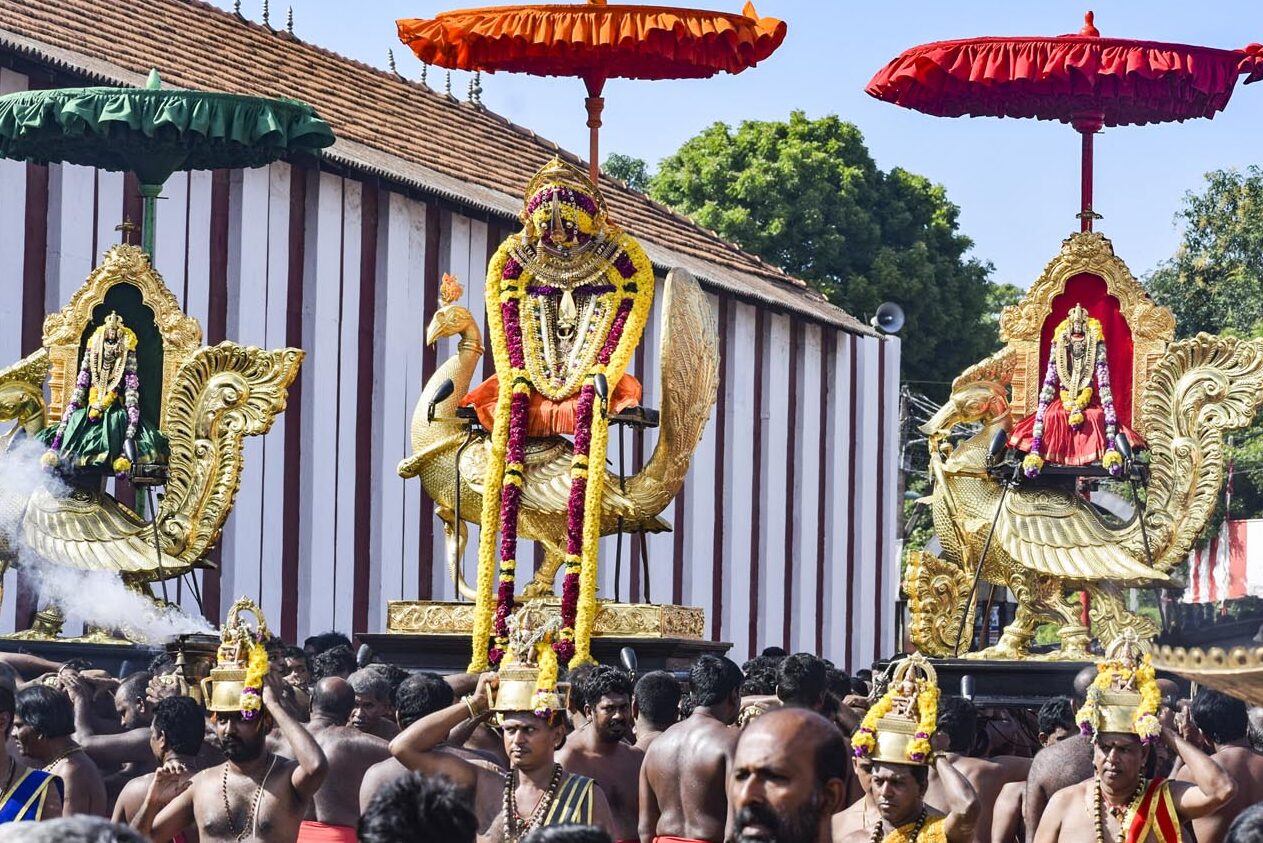
The streets of Jaffna came alive during these days, with homes and roads adorned with mango leaves, coconut fronds and flowers. I was struck by the intricate kolam designs decorating the ground, each one a sacred yantra invoking blessings from Lord Murugan. The entire town was transformed into a vibrant spiritual canvas. Statues of Lord Murugan were carried in daily processions on various sacred vahanas, including silver and green peacocks, bulls, horses, cobras and swans—each symbolizing different aspects of His divine nature. The festival culminates in the Tiru Kalyanam—Lord Murugan’s divine wedding.
The Festival Experience
From the moment you step into the temple’s sacred premises, the energy is palpable. I had the opportunity to experience pujas and processions firsthand. Each day had its own significance, with rituals that unfolded in the inner sanctum and then spilled into the surroundings as night falls. Processions often went late into the evening, filling the air with the hum of sacred chants, drums and nadaswaram music.
Devotees explained the key ceremonies to me. Beginning on August 8 this year, the powerful form of Siva called Bhairava, whose vehicle is a dog, was invoked for His protective blessings over the 27-day event. The canine-shaped chariot, draped in black flags and symbols, carried the Deity in a grand procession around the temple at dusk.
This invocation was followed by kodiyetram, the ceremonious flag hoisting that signaled the official start of the festival. Eyes filled with tears as the intricate flag cloth, woven by the Sengunthar Mudaliyar descendants, was carried to the temple in a chariot amidst chants of “Alankara! Nallura!” As the flag was raised, Lord Murugan’s Vel was symbolically placed on a silver peacock chariot, followed by His consorts, Valli and Devayani, as the entire community united in one purpose—to celebrate and invoke divine blessings.
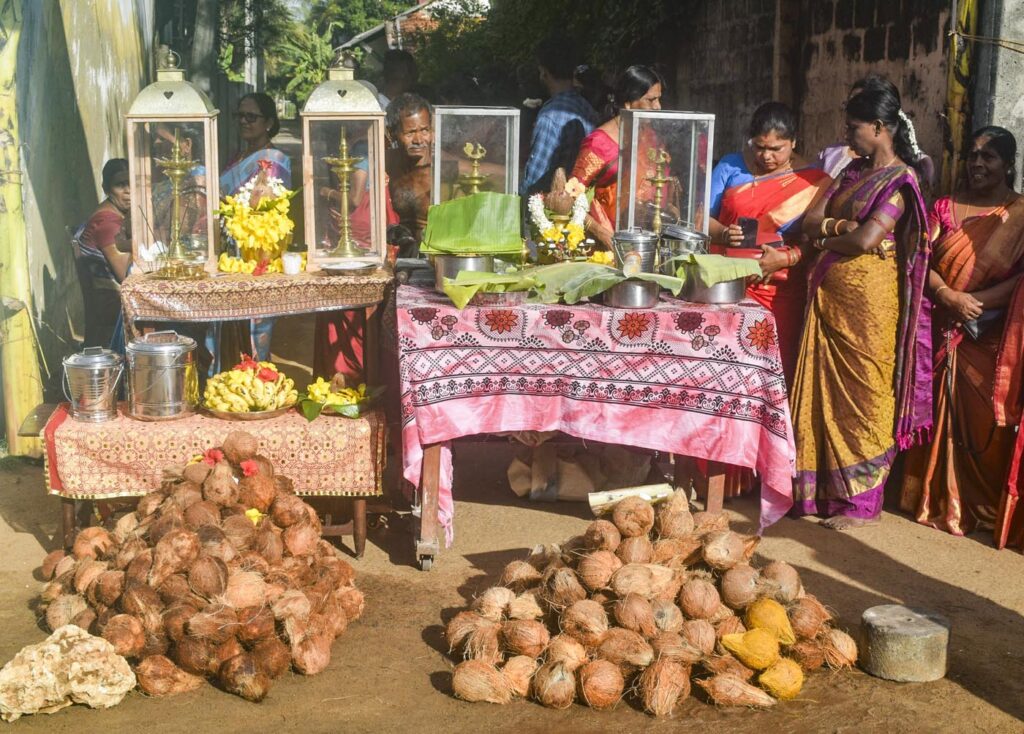
The Mancham Festival, held on day ten, was particularly awe-inspiring, devotees explained. The slow-moving Mancham chariot, symbolizing Lord Murugan’s bed, adorned with intricate depictions from Puranic stories, lit up the night.
On day 17, the great Tamil Saiva poet Arunagirinathar, who composed the Tiruppugazh, was honored through a reenactment of his temporarily taking the form of a parrot to access celestial realms. Dressed in parrot-green attire, the priests and officials added a colorful flair to the evening, making it feel like the spirit of the saint was very much present, singing the praises of Lord Murugan.
One of the unique and unforgettable aspects of the festival was the Suriyotsavam, or Sun Festival, on the 19th day. A stunning chariot, symbolizing Suriya riding with His wives, was pulled around the temple at dawn by seven horses.
The evening of the 20th day featured one of the most intricate and beautiful chariots. It depicted Mount Kailasa, the heavenly abode of Lord Siva which Ravana attempted to lift. Lord Murugan in His majestic Vel form was seated in it with His two wives. The next morning, day 21, focus shifted to Goddess Durga, or Maha Kali. Her chariot resembled the mythical Yali, a creature part lion, part elephant. That same evening, Muruga rode the iconic golden chariot, drawn by golden horses. The entire atmosphere turned pink with flowers, decorations and clothing awash in this vibrant hue.
The morning of day 22 was the Thandauthapani Utchavam, the Mango Festival. This was a reenactment of the story in which Lord Murugan—after losing a race around the world for a mango to His elder brother Lord Ganesha—retreated to Palani Hill in South India as a sadhu, dressed in a loincloth and carrying His Vel. The energy of the festival took a dramatic turn with the evening event, which symbolized Lord Murugan embarking on a hunt. Dancers, musicians and soldiers parade alongside Him, while the priests carried weapons instead of the usual puja items (photo far right).
On the 23rd day, in the evening, Lord Murugan rode on the massive Sapparam chariot. The sheer size of the chariot and the number of devotees pulling it was a sight to behold. If there’s one day that stood out above the rest, it was the 24th day—the Ther Thiruvizha, or Chariot Festival. Thousands of devotees gathered, chanting and pulling Lord Murugan’s colossal six-headed, twelve-armed murthi. The drums, nadaswaram and temple bells created a rhythm that seemed to shake the heavens. Lord Shanmuga was seated regally, dressed in dazzling attire, as confetti of flowers showered from the skies.
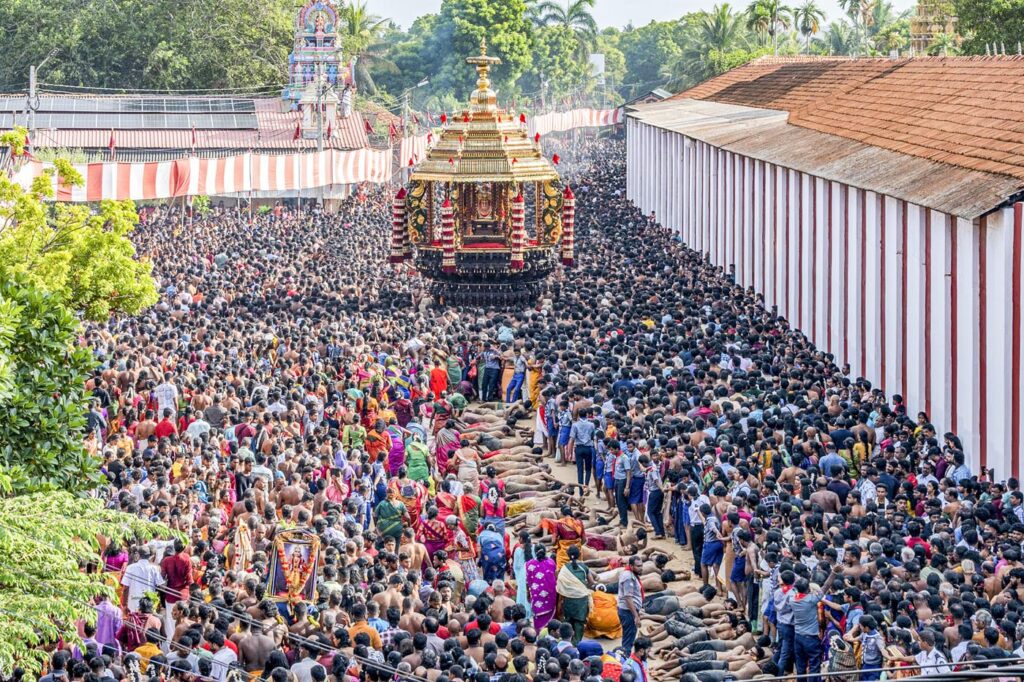
On the 25th day, the Theertham, or Holy Bath, takes place. After symbolically defeating the forces of evil, the Deity was bathed in the temple’s sacred tank, which in turn purified all who participated. I, too, felt spiritually lighter, as if washed clean of difficult karmas.
That final evening, the flag, hoisted two weeks earlier, was ceremoniously lowered. The chariot decorations and clothing were predominantly white for this event. The flag was returned to the Sengunthar Mudaliyar family, signaling the end of the festival proper. But it was not over yet.
The Epilog
One of the heartwarming rituals was the reenactment of Lord Murugan’s marriage to His second wife, Valli, on the 26th day. It was playful and full of love, especially the part where His first wife, Devayani, locked the newlyweds out of the temple until songs of negotiation convinced Her to open the doors. The drama and music made it feel like we were witnessing a divine family moment.
The final day, September 4 this year, brought a deep sense of closure. Lord Bhairava, who had guarded the festival from start to finish, was honored once again. It was a quiet, reflective moment as His special guardianship was paused until the next year. The festival came to a close as the chariot carrying the temple’s murthi of Lord Murugan returned Him to His inner sanctum.
The Major Elements
The Nallur festival is not just a religious event; it’s a cultural phenomenon that leaves a profound spiritual impact on everyone who participates. Following are some of the key rituals and customs I experienced during the event.
One of the most intense rituals I observed is the kavadi attam, also known as the burden dance. Devotees carried a kavadi—an intricately decorated, semicircular structure adorned with flowers and peacock feathers—on their shoulders while dancing in a trance-like state. Many had a small spear inserted through their cheeks and tongue as a kind of penance. The kavadi represents the burden of devotion offered to Lord Murugan and the dance was a deep act of faith and atonement.
Even more extreme was the paravai kavadi, in which participants had silver hooks pierced into their back. Ropes were attached to the hooks and the devotee suspended face-down from elevated carts decorated with bells. The carts moved in procession through the streets.
I observed angapradakshinam, where devotees rolled their bodies along the temple’s hot sand pathway, either while following a chariot or on their own. With arms outstretched and hearts full of prayers, they rolled completely around the temple, with head facing the sanctum sanctorum, all while chanting “Alankara! Nallura!!”
Among the more dramatic rituals is the mass breaking of coconuts outside the temple. As devotees hurled coconuts, the cracking sound filled the air, symbolizing the breaking of the ego and the release of purity within. It was an incredible sight—hundreds of coconuts being broken one after the other in an energetic flurry.
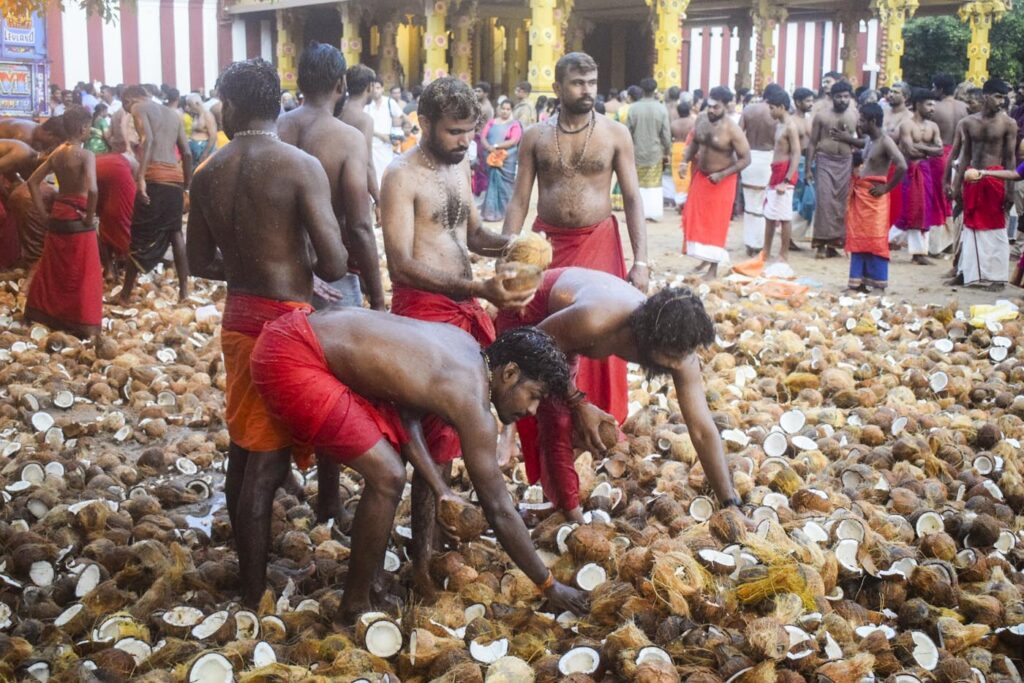
The thee chatti, or fire pot ceremony, was performed by female devotees. I watched as women, barefoot, carrying small pots filled with burning coals in their hands, walked around the temple in prayer. This act of devotion symbolized the purification of the soul.
Devotee Reports
I had the opportunity of hearing accounts from various devotees about divine intervention and answered prayers that profoundly deepened their connections with Lord Murugan. One particular story that resonated with me was that of a local teacher from Jaffna. Battling severe health issues and financial difficulties, she approached the temple with unwavering faith. After immersing herself in a series of rituals and heartfelt prayers, she experienced a remarkable recovery and a turnaround in her fortunes.
Another touching narrative involved a family from Colombo with the father struggling with alcohol addiction. Through spiritual guidance gained at the temple, he found solace and redemption. Their path to the temple was filled with rituals and acts of devotion, ultimately leading to the man’s successful rehabilitation.
One Tamil family I met came from Switzerland. They had left their homeland decades ago during the civil war and always dreamed of returning to visit the temple. They described their current trip as a pilgrimage not only reaffirming their identity but also deepening their appreciation for their heritage. For this family, the experience allowed them to reconnect with their roots and find the sense of belonging that they longed for.
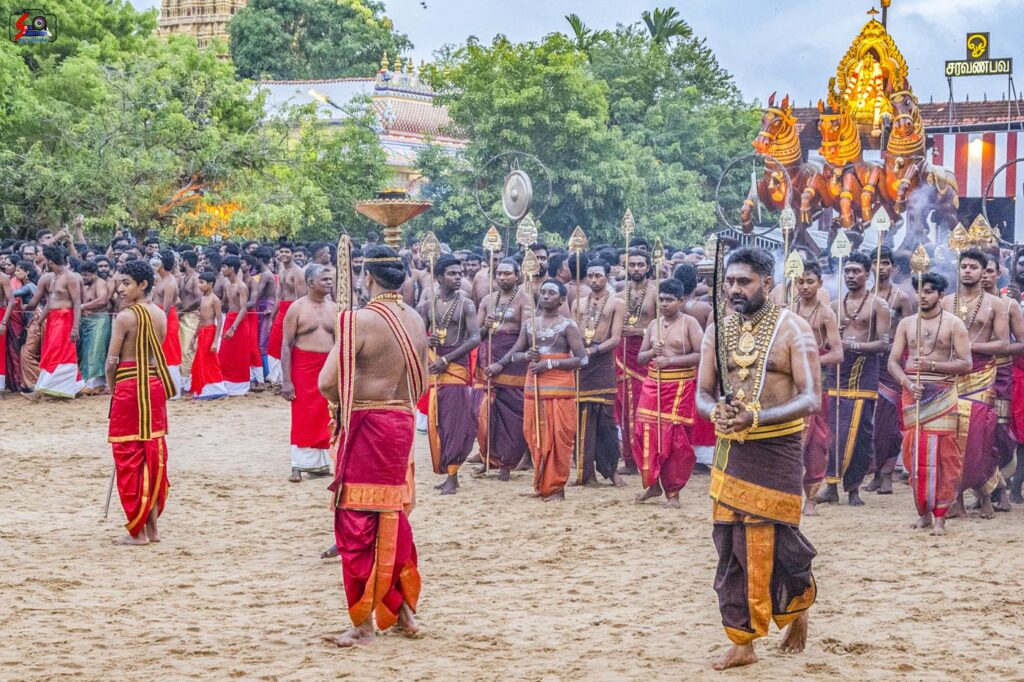
As I listened to these narratives, I couldn’t help but notice a common theme—devotees viewing their visits as transformative journeys offering a profound sense of peace and connection.
A True Community Event
A remarkable aspect of the Nallur Murugan Festival was the sense of unity and shared devotion among the participants. The festival brought together thousands of devotees, all united in their love and respect for Lord Murugan.
A delightful part of the festival experience for me was annadhanam, the tradition of serving free meals to devotees. The scale of this operation was impressive—volunteers worked tirelessly, from chopping vegetables to cooking massive quantities of food. The meals, offered as prasadam, were simple but delicious, consisting of rice, vegetables and local sweets.
One touching tradition I encountered is the thanneer pandhals—refreshment booths set up by local families around the temple. Walking long distances in the heat, I, like many other devotees, were grateful for the free drinks offered at these booths. From buttermilk to sherbet, each refreshing sip felt like an offering of kindness and hospitality. What struck me most is that these booths have been set up by the same families for generations, showing their commitment to ensuring no devotee goes thirsty during the festival.
The homes surrounding the temple are beautiful to behold, especially as the chariot carrying Lord Murugan approaches. In front of many houses, families offered padayal—a traditional blessing that includes a lit oil lamp, puja items and food. When the chariot passed by, the families waved the sudam—the sacred fire—and broke coconuts. What makes this moment even more special is the sharing of these offerings with others on the street as prasadam.
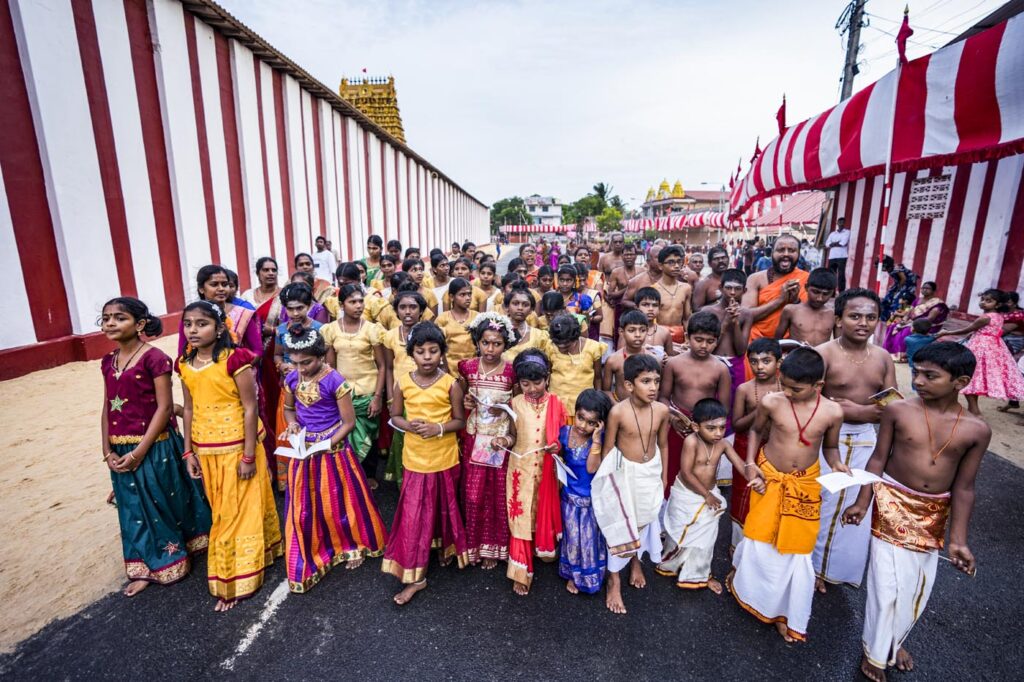
One enchanting moment during the festival was hearing the sweet, angelic voices of children singing Thiruppugazh from their homes as the chariot moved through the streets. The children’s heartfelt singing as they stood with their families welcomed the chariot.
I witnessed beautiful Bharatanatyam performances that brought to life stories and themes connected to Lord Murugan. Accompanied by Carnatic music, the dances added an artistic depth to the festival—beyond entertainment, it was a spiritual expression through movement and sound.
Needless to say, the festival has a profound impact on the local economy, bringing business to local hotels, restaurants and shops, as well as providing temporary employment for many locals as guides, vendors, transport operators, etc.

Creative Touch Imaging Ltd/Zuma Press/Newscom 2017
Conclusion
For me, the Nallur Murugan Temple pilgrimage is a transformative journey that offered peace, connection and spiritual fulfilment. I found myself immersed in timeless rituals, surrounded by intricate decorations and unwavering devotion, which truly embodies the essence of Hindu spirituality. In the presence of Lord Murugan, I felt a deep sense of comfort and divine grace, reaffirming my faith and strengthening my bond with my heritage and spiritual roots. ∏π
Additional photos can be seen here: bit.ly/NallurPhotos; and a video on the festival here: bit.ly/NallurVideo
Annual Festival in Full Swing
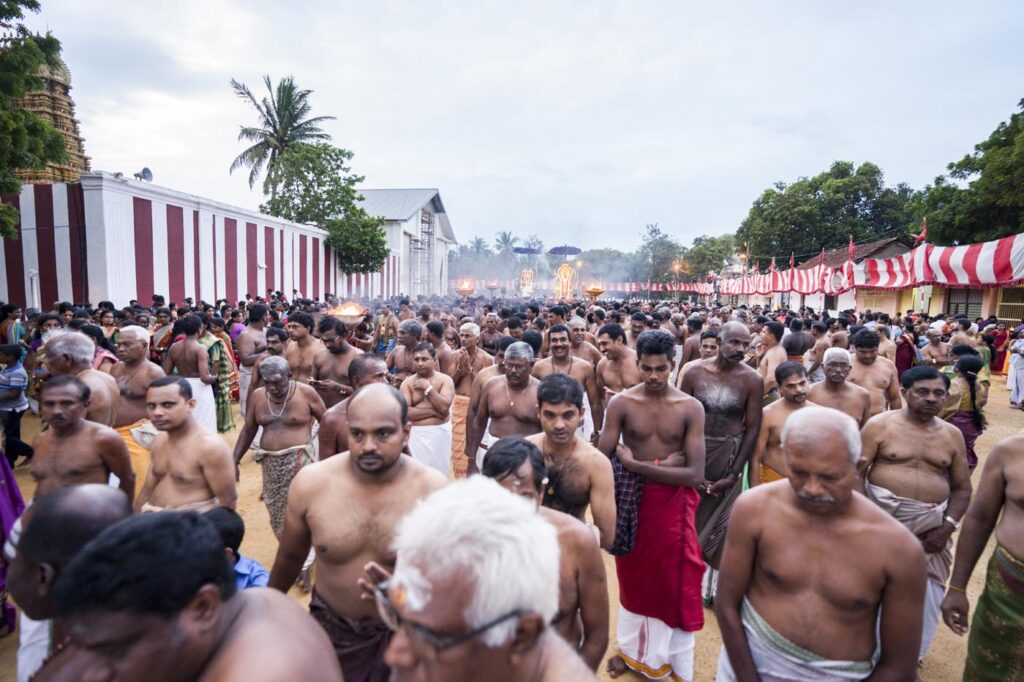
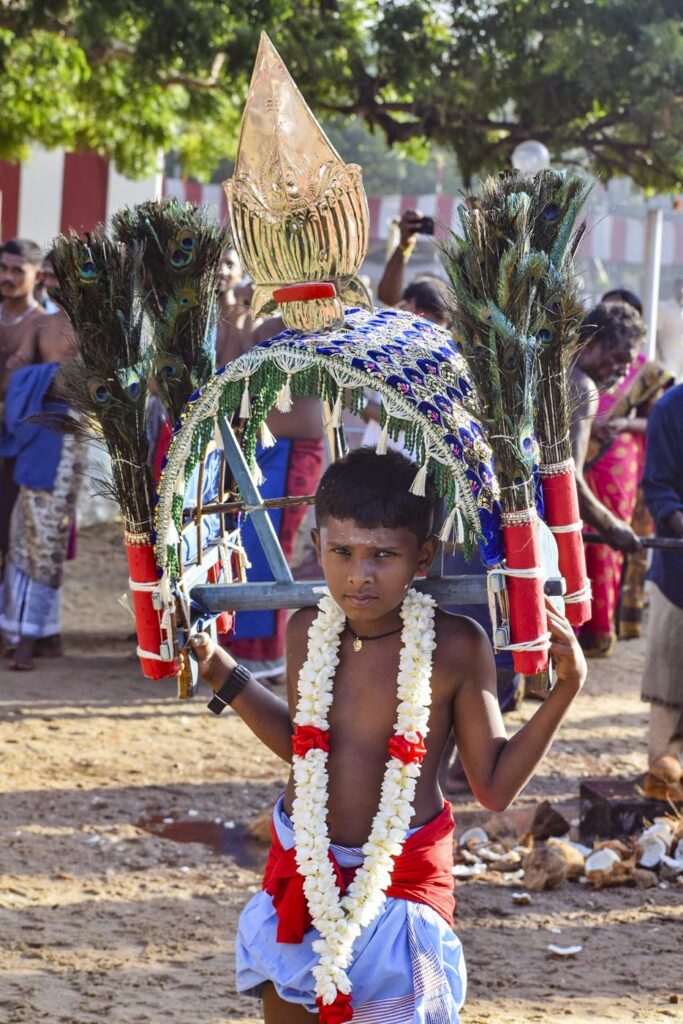
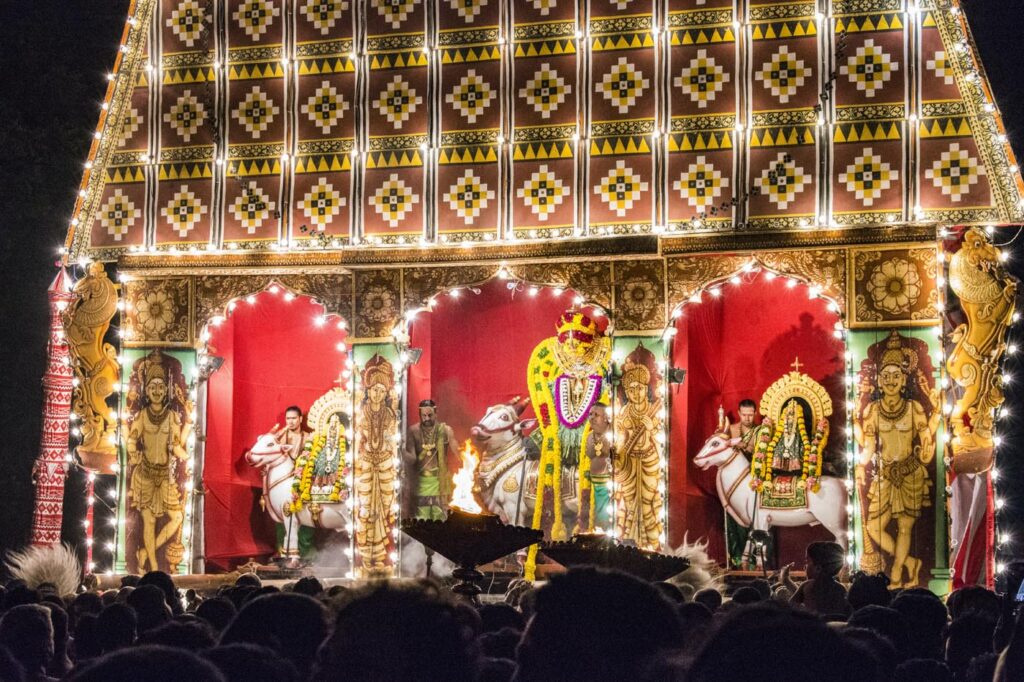
Penance, Devotion, Celebration and Song
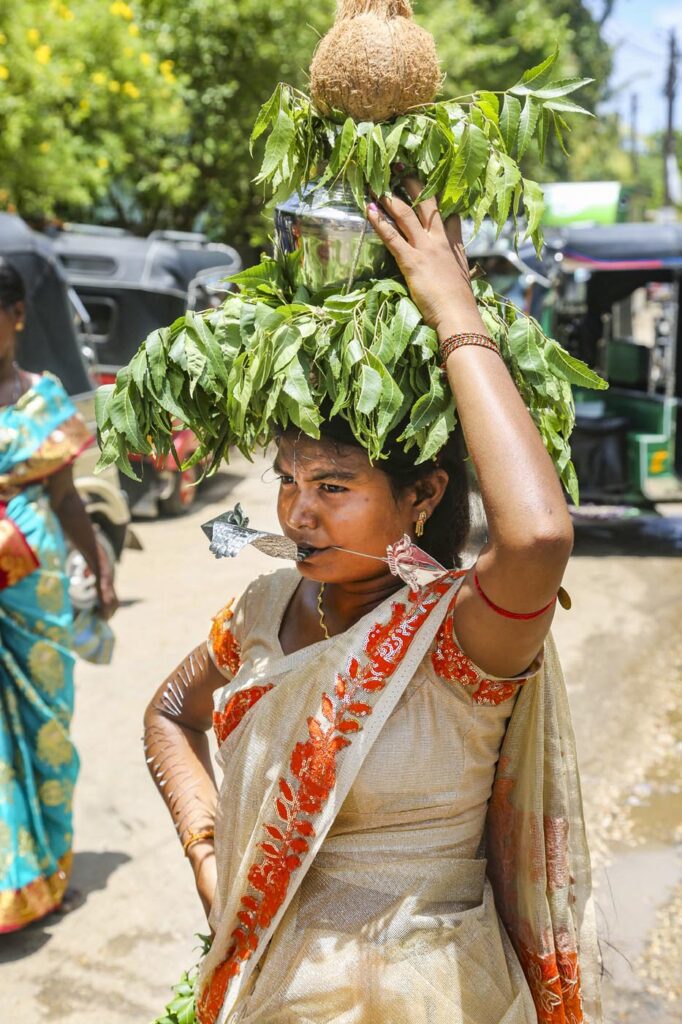


Public Penance, Performances and Huge Offering of Coconuts
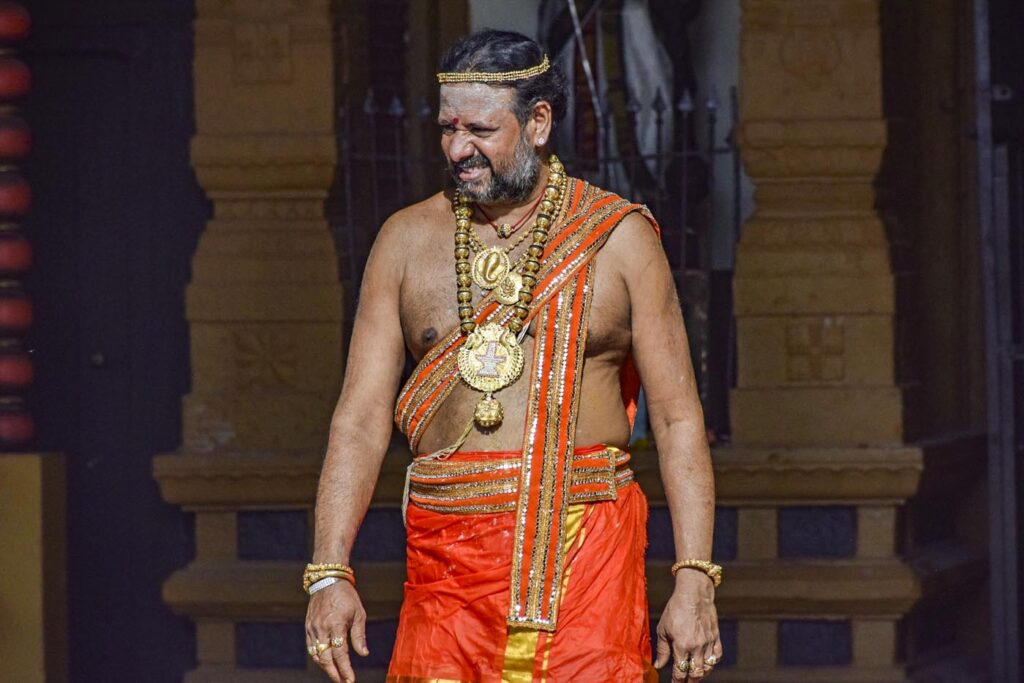
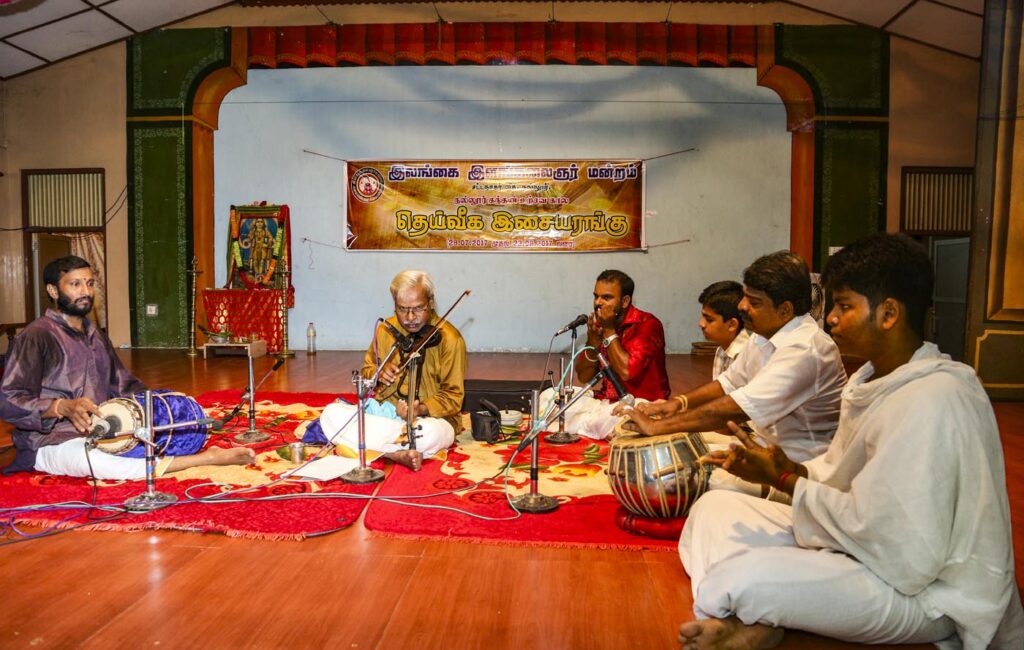
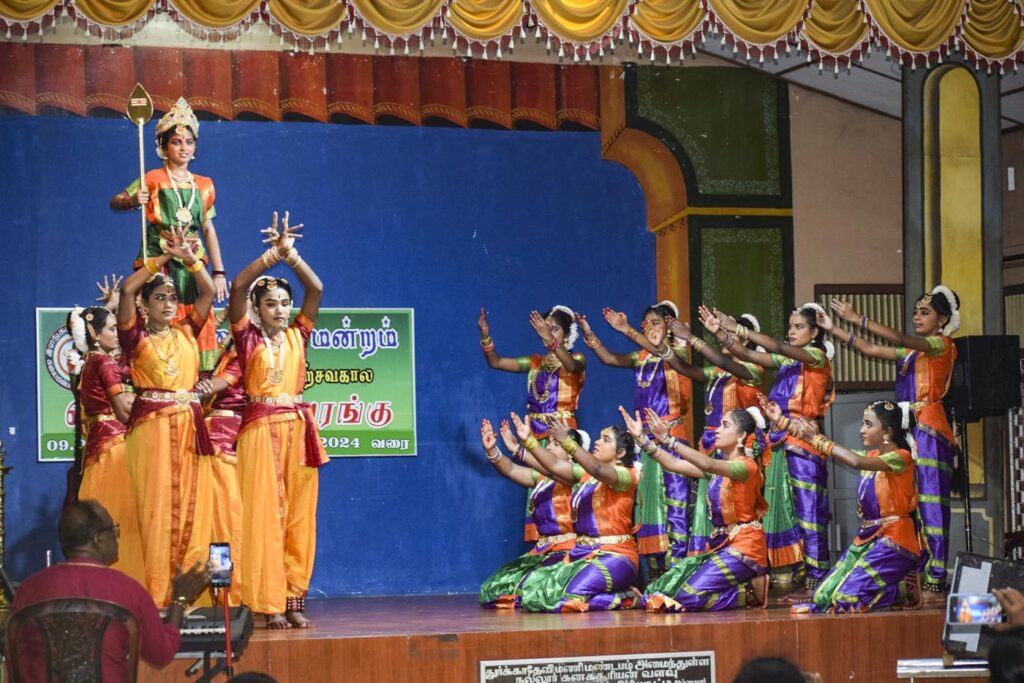
Penance in Many Forms

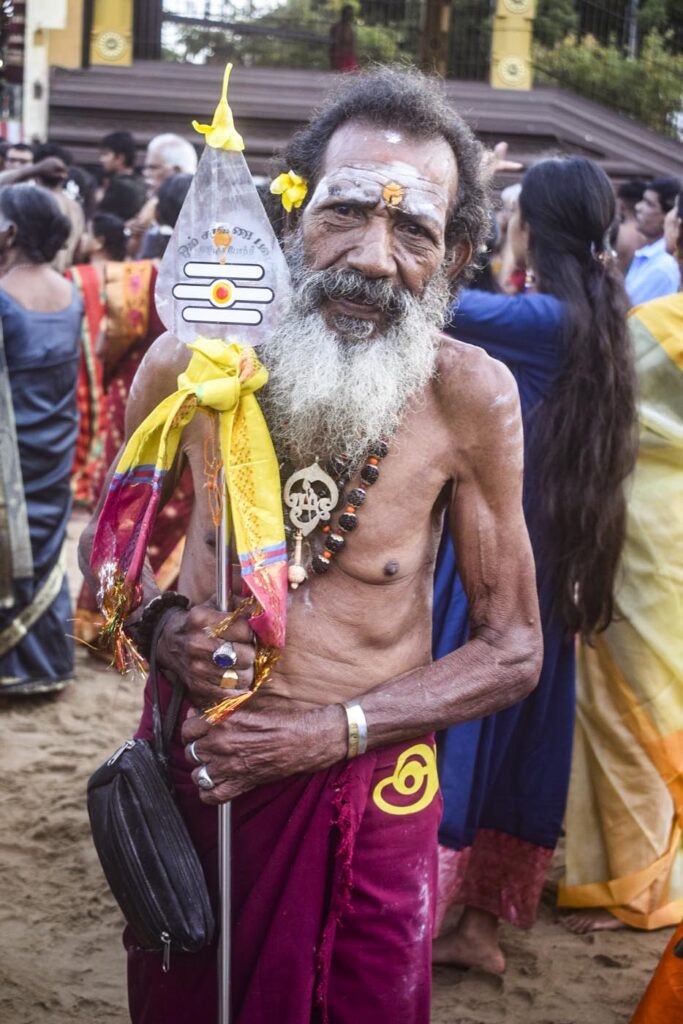
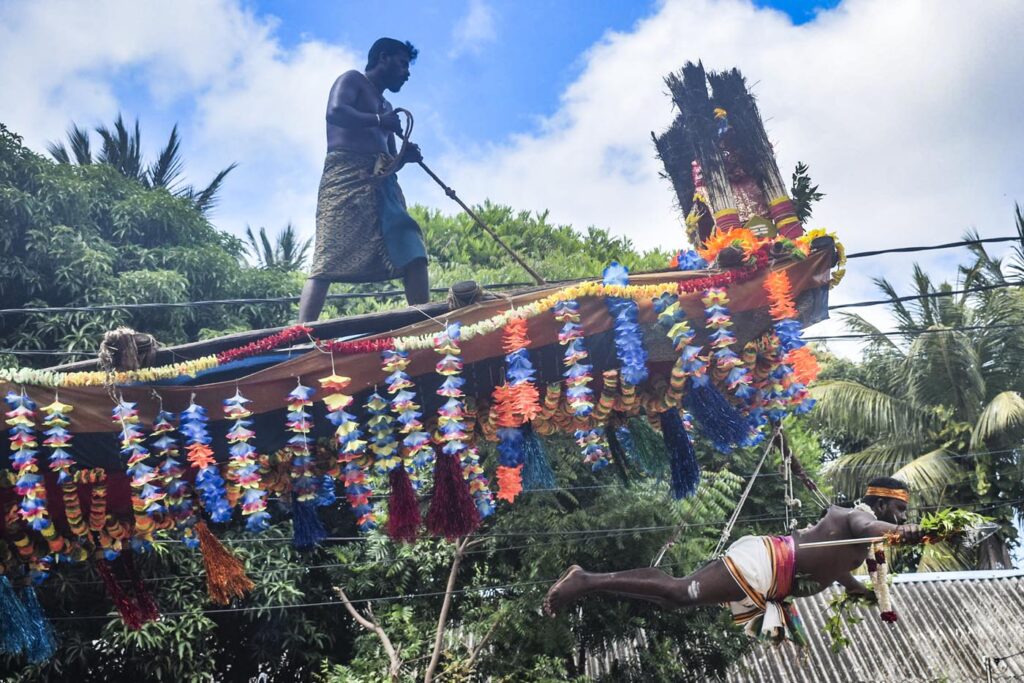
Endless Variety
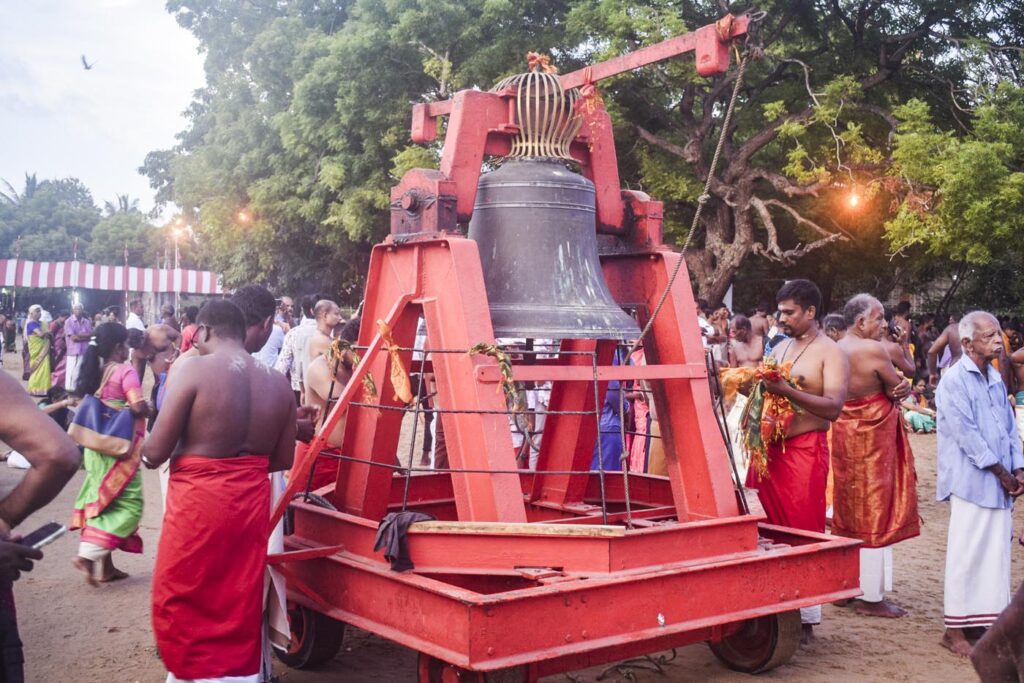
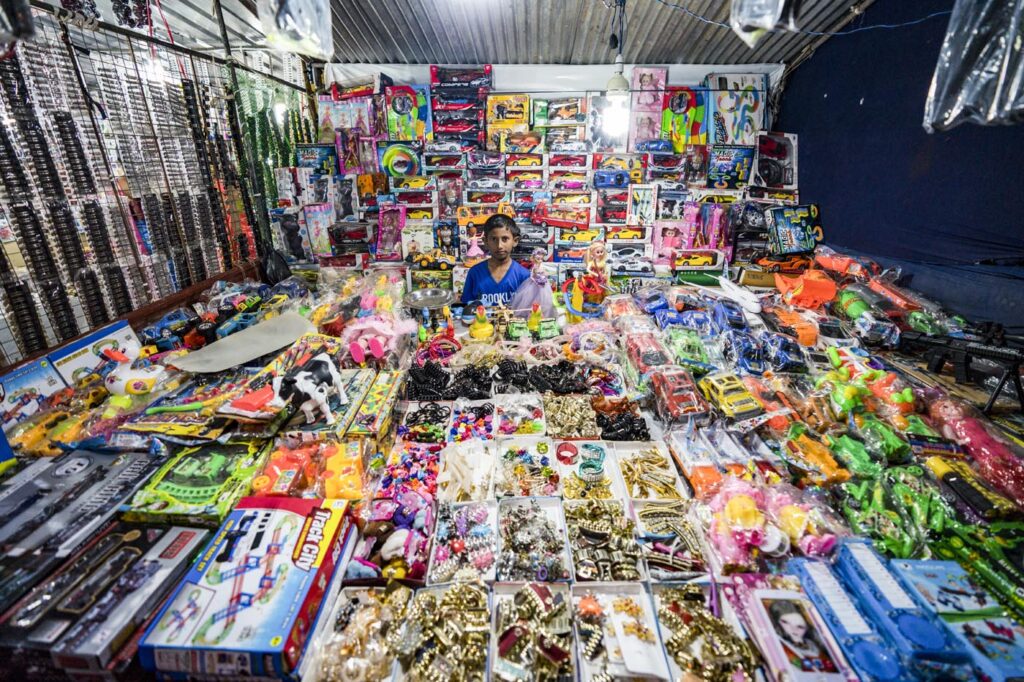
Jaffna Becomes a Pilgrimage Destination
By Rishi Thondunathan
As the successor to Yogaswami of Sri Lanka, Gurudeva Sivaya Subramuniyaswami held a deep connection with the country and its people. With his guru Yogaswami’s blessings, Gurudeva established his first ashram in Sri Lanka 75 years ago. Since then, he has played a significant role in the lives of the Saivite Tamil community, especially during challenging times. When the civil war began in 1983, Gurudeva founded the Sri Lankan Tamil Refugee Relief Fund, which helped hundreds of families. As the conflict escalated, people began emigrating to North America, Europe and other countries, yet they remained in close contact with Gurudeva. In the 1990s, he visited refugee camps across Europe, offering comfort and encouraging families to settle and raise their children in these new lands. He urged communities to build temples, preserving their religion and culture.
Today, three decades later, hundreds of temples founded by Sri Lankan Tamils flourish across Europe, North America and Australia. During the 1990s, Gurudeva continued to guide the diaspora through lecture tours, phone calls and other media. I had the privilege of accompanying him on these journeys, translating his talks into Tamil.
Gurudeva strongly believed in a peaceful political resolution to the conflict in Sri Lanka. During that time, he even arranged meetings and spoke with peace negotiators, urging them to seek a peaceful solution to the ongoing civil war.
Once he told me, “After the war, Jaffna will become a place of pilgrimage.” When I asked for clarification, he explained, “Now, thousands of Tamils are forced to leave their homeland. Many believe they will return after the war, but in reality, as they settle and raise their children and grandchildren in their new countries, the second and third generations will be less inclined to move back permanently. However, they will feel a connection to their ancestral homeland and be drawn to visit it. What will attract them back are the village temples and holy sites in Sri Lanka.”
Today, we are witnessing Gurudeva’s prophecy. The war ended in 2009, and as time has passed, damaged temples have been restored with renewed grandeur. The diaspora has returned to rebuild their village temples, and now we see these people and their descendants making pilgrimages to their homeland, particularly during temple festivals and special occasions.
The Nallur Temple stands as the most significant pilgrimage site for Sri Lankan Hindus. During its annual 25-day festival, thousands of devotees come to worship Lord Murugan at Nallur. Many former Sri Lankans now living abroad make it a point to return to Sri Lanka for this event. The Nallur Temple is a vital pilgrimage site for Hindus in Sri Lanka, attracting not only Hindus but also Buddhists, Muslims, Christians and people from all walks of life. Daily, busloads of visitors from the south come to this temple, as well as many foreigners. Nallur Temple is a source of pride, heritage and legacy for Sri Lankan Hindus, and the influx of pilgrims provides a much-needed boost to Sri Lanka’s economy.
In our guru lineage, four of the revered satgurus have shared a profound connection with Nallur Murugan. I am certain these satgurus continue to bless and guide us from the inner world.
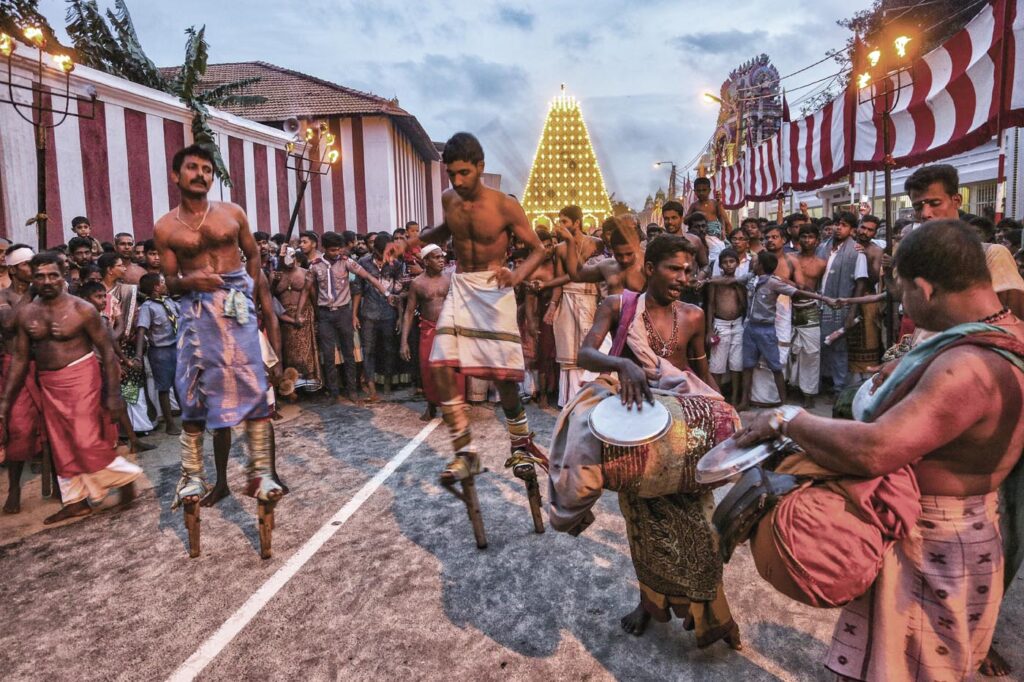
About the Authors
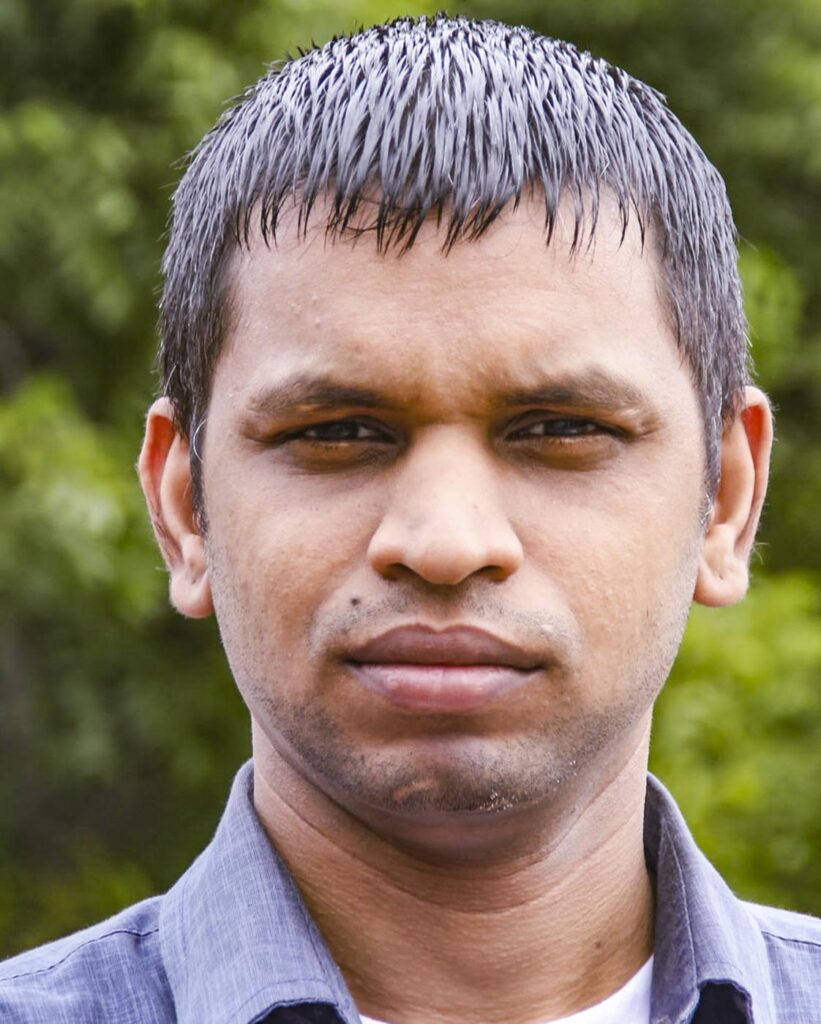
Balakumar Muthu is a software consultant, avid traveler and culture photographer blogging at
CasualWalker.com.
